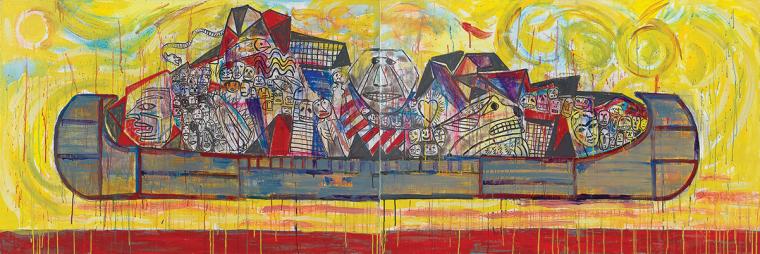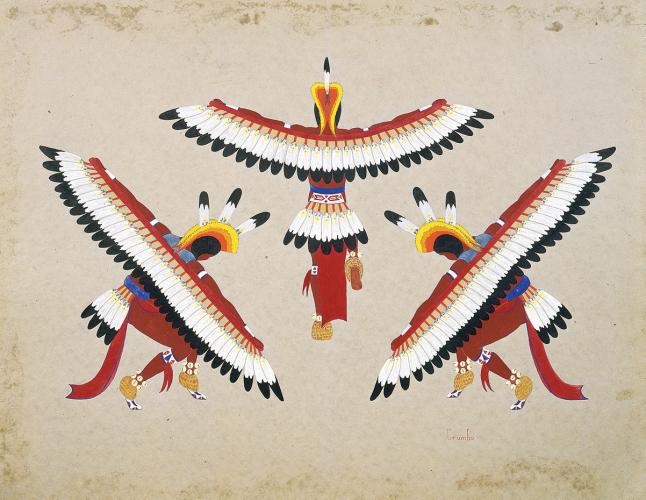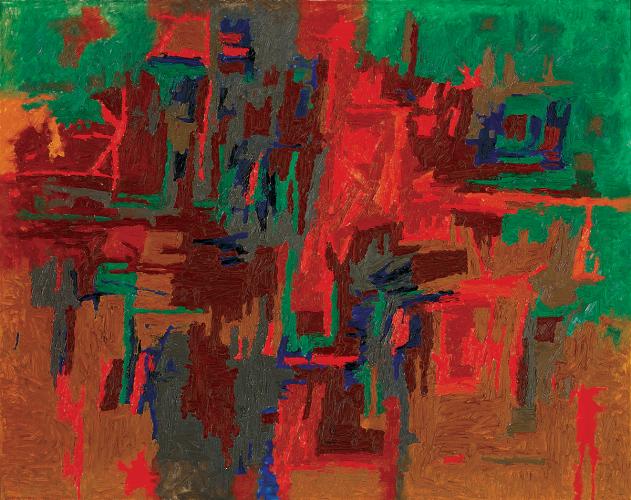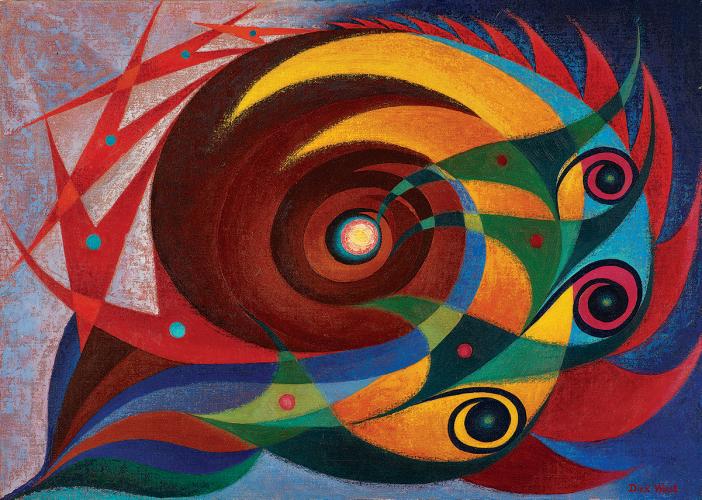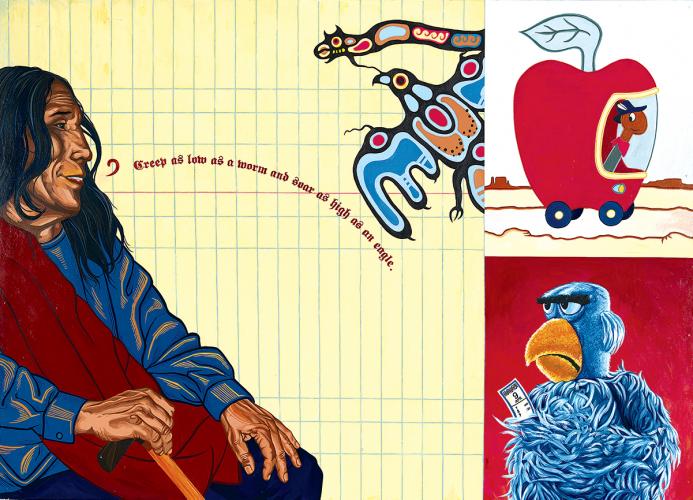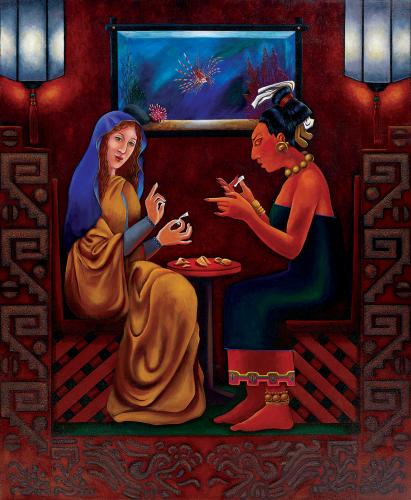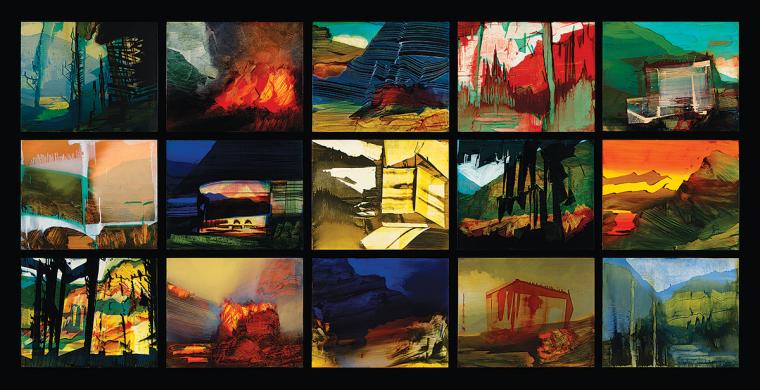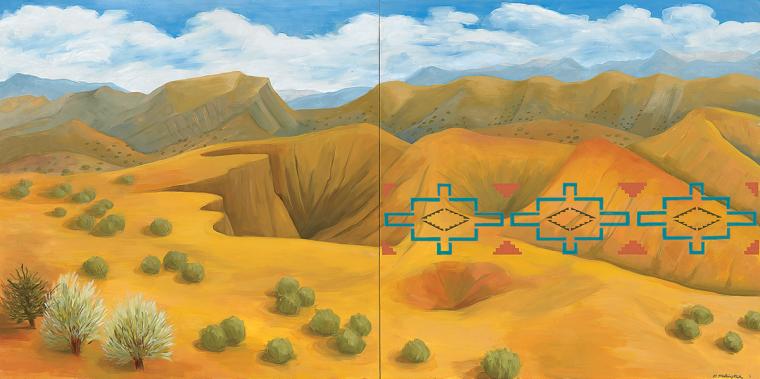Even amidst New York City’s constant parade of superb fine-art shows, the National Museum of the American Indian’s exhibition, “Stretching the Canvas,” stands out, not just for the beauty of the paintings on display but for the story they tell. Upon entering the first gallery, one will encounter a series of mammoth paintings that pulse and mesmerize, offering up a rich buffet of color, shape and texture. Here’s Jaune Quick-to-See Smith’s 10-foot-long painting of a crowded canoe, then James Lavadour’s 15 separate landscapes arranged like a huge quilt, and yet another, George Morrison’s grainy white abstraction with a faint horizon line that gives the piece gravity—each painting clamoring for attention.
These and the other 29 artists whose art— all from NMAI’s collection—will be featured in this exhibition are among the most accomplished Indian painters of the 20th and 21st centuries. “For American Indian artists in the 20th century, the act of painting and stretching a canvas was a revolutionary act,” says lead curator David Penney. For much of the 20th century, most art historians, philanthropists, museum curators, art patrons and gallery owners dismissed Indian art as folk art or merely decorative and did not consider it to be among the pantheon of fine arts. Opening in November 2019 and running through fall 2021, “Stretching the Canvas” reveals how American Indian artists have challenged these expectations during the past eight decades, bursting through artificial boundaries and actively challenging long-entrenched ideas about what Indian art should look like. In doing so, they opened up exciting new worlds of creative expression.
“Each of the artists in this exhibition has had to contend with and overcome numerous unspoken restrictions and expectations,” says curator Rebecca Trautmann, one of the five NMAI curators who worked on the exhibit. The artists’ often difficult journeys toward defining their own styles have lent their work urgency and freshness.
The earliest pieces in the exhibition date from the 1930s through the 1950s. Most of the artists who created them trained at the Santa Fe Indian School and Bacone College in Oklahoma— the first formal educational opportunities for many Native painters. Teachers and federal officials determined that a “traditional,” recognizable Indian art style could turn into an economic strategy that could help struggling Indian communities. Deriving a style from the kiva paintings and Plains battle scenes painted on buffalo hides, the government school curricula pushed their Indian students to paint in flat, narrative styles. Teachers such as Dorothy Dunn at the Santa Fe school emphasized the portrayal of ceremony and Native dress, all intended to present the Indian artist’s culture to the dominant white culture. Potawatomi artist Woody Crumbo’s painting, “Three Eagle Dancers,” is one of the works in the exhibition that epitomizes this early style, eschewing such techniques as perspective, color shading and background.
American Indian art and the avant-garde did not begin to come together until after World War II. The Philbrook Museum in Tulsa, Oklahoma, began sponsoring an annual Indian art show during the 1940s. The show’s jurors famously rejected a painting by Yanktonai Dakota Oscar Howe in the late 1950s for not being Indian enough. For Howe, it begged the question: What was Indian art? “I only hope the Art World will not be one more contributor to holding us in chains,” he wrote in a letter to the jurors.
Ojibwe artist George Morrison also had no interest in being pigeonholed as an Indian painter. In the 1940s, he left Minnesota to study at the Art Students League in New York City, where he became deeply influenced by Abstract Expressionism and exhibited with such well-known avant-garde artists as Franz Kline and Willem de Kooning. Morrison’s abstract canvases contained no visible elements of traditional Indian art. The beauty of his work—as well as how boldly he charted his own path as an artist while still maintaining his connection to his culture and geography—would inspire a new generation of Indian painters.
The authors of NMAI’s “Native Universe: Voices of Indian America” tell how in the 1970s Luiseño artist Fritz Scholder would also challenge convention by embracing pop art and abstract expressionism to paint the Indian “real, not red.” He would become an influential member of the New American Indian Art movement. The “Stretching the Canvas” exhibition features three of Scholder’s works, including “Indian and Rhinoceros.” The animal represents the lumbering U.S. Bureau of Indian Affairs that cannot help but destroy everything in its path.
Such ironic statements began to creep more and more onto Indian canvases in the latter part of the 20th century, becoming a powerful tool for artists to challenge the dominant culture’s stereotypes about Indians. For example, in “Fortune,” the Maidu painter Judith Lowry depicts a Mayan goddess seated with the Madonna. Deeply influenced by early Renaissance painters and artists from California, Lowry uses allegory to challenge stereotypical representations of Native peoples and issues of consumerism and religion in contemporary life.
Abstract compositions also served as effective tools for Indian artists to escape the binding strictures of “traditional” Indian art. Dick West (Southern Cheyenne) became famous for his illustrator-style images of Cheyenne ceremony and mythic stories. Yet for his 1950 Masters of Fine Art degree at the University of Oklahoma, West submitted his colorful, dynamic “Spatial Whorl” along with five other paintings inspired by non-Indian art trends, including modernist abstraction.
Late modernism and postmodernism styles of the 1960s and 1970s influenced Cherokee painter Kay WalkingStick. Her “New Mexico Desert” features a soft desertscape overlaid with Navajo textile patterns, which calls out for a new way of looking at the landscape—and a reassertion of the claim of Native peoples to the land. In 1995, Walking-Stick became the first American Indian to be included in H.R. Janson’s seminal art history survey, “History of Art.”
The newest canvas in the show is “Trade Canoe: Adrift,” which Jaune Quick-to-See Smith painted in 2015. The 3-by-10-foot canvas depicts an overloaded canoe, filled with Syrian refugees floating under the blistering heat of several suns. The Salish/Cree/Shoshone artist addresses the issues of displaced peoples worldwide through the lens of the Indian canoe, which brought important trade goods and cultural innovations but also disease and weaponry. The masks, fish and water allude to the struggles by the Duwamish people of Washington State to gain federal recognition, which would assure their community’s fishing rights.
Smith and these later painters have certainly shed previous notions of what an Indian painting must look like. No uniform visual cues or styles define their work today. If any one theme runs through these works, says Penney, it is that they all are influenced by their life experiences as Indians. “That makes them accountable to their communities,” he says. However, the unique and often vibrant approach that each artist decided to take to do so is what makes this exhibition such a delightful and provocative journey through time.

